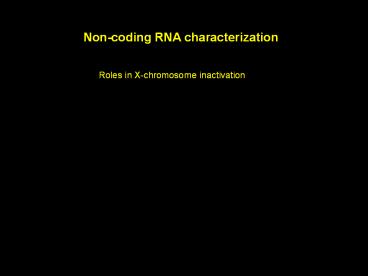Non-coding RNA characterization - PowerPoint PPT Presentation
Title:
Non-coding RNA characterization
Description:
Non-coding RNA characterization Roles in X-chromosome inactivation This paper sought to reveal the mechanisms by which Xist silences the X chromosome. – PowerPoint PPT presentation
Number of Views:91
Avg rating:3.0/5.0
Title: Non-coding RNA characterization
1
Non-coding RNA characterization
Roles in X-chromosome inactivation
2
This paper sought to reveal the mechanisms by
which Xist silences the X chromosome. what
elements are important for exclusion of
transcription machinery and nuclear
reorganization? what are the temporal and
spatial characteristics of Xist-mediated
silencing?
3
Is there a relationship between RNA pol II and
Xist RNA accumulation?
4
(No Transcript)
5
(No Transcript)
6
(No Transcript)
7
- Summary of fig 1
- Spatially, transcription machinery excluded from
the Xist domain - Repressive epigenetic modifications are
associated with the Xist domain - Temporally, exclusion is followed by epigenetic
chromatin changes - exlcusion is an early event differentiation day
1 - epigenetic modification is a later event day 2
8
- Paradox
- Prior data shows that X-linked expression falls
on day 2-4 of differentiation - (Keohane AM, et al. X-Inactivation and histone
H4 acetylation in embryonic stem cells. Dev Biol.
1996 Dec 15180(2)618-30.)
Resolution - Examine lifetime of x-linked RNA
transcripts by RNA FISH and RNA pol II IF
9
(No Transcript)
10
(No Transcript)
11
(No Transcript)
12
- Fig 2 summary
- Exclusion of machinery occurs earlier than
repression - - expression persists during differentiation day
1 and 2 - - machinery is excluded during the observed
expression - - persistence of primary transcripts causes
delay in silencing - Jarid1c escapes complete inactivation because it
is distal to Xist locus - Depletion of Cot-1 RNA signal follows RNA pol II
exclusion - further identifies the temporal relationship
between repression and RNA pol II exclusion - Genes at the periphery of Xist domain lag in
repression
13
Role of spatial organization in determining txn
state - Xist induced relocalization - gene
position relative to Xist RNA domain
Using 3D reconstruction analysis - identify
Xist domain via RNA FISH - identify repressed
gene locations via DNA FISH
14
(No Transcript)
15
(No Transcript)
16
- Fig 3 summary
- X-linked genes are re-localized toward the
interior of the Xist RNA domain during
differentiation - This re-localization is associated with
repression of the genes further into the Xist
domain
17
Role of Xist A repeats - ?A constructs -
cannot induce silencing - can coat in cis
correctly - can induce same histone
modifications allows distinction between changes
due to Xist silencing or chromatin modifications
18
(No Transcript)
19
(No Transcript)
20
- Fig 5 summary
- A-repeat region not necessary for
- exclusion of RNA pol II
- repression of Cot-I
- formation of silent nuclear compartment
- delta-A Xist failed to silence X-linked genes
- genes were not re-organized into the silent
compartment
21
Conclusions
- Xist RNA forms a silent nuclear compartment
during female ES differentiation - Txn machinery is rapidly excluded followed by
silencing of genes - Exclusion is proceeded by epigenetic silencing
modifications - Silencing is correlated to position relative to
the Xist domain - Xist domain presents a repressive environment
- Xist induces relocalization of genes to the
silent Xist RNA domain - Function of A-repeat region of Xist
- Not needed for formation of the silent
compartment - Not needed for exclusion of RNA pol II
- Required for gene re-localization
22
(No Transcript)
23
- Discussion ?
- Is their measure of RNA pol II exclusion
accurate? - Is fluorescence an accurate enough measure of
transcriptional state? - What about the converse experiment? express just
the A-repeat region - Experiments using truncations of the delta-A
construct. - Does the Xist domain co-localize with the
nuclear structure components? - What is the nature of this repressive RNA
domain? - How do Polycomb Group complexes fit with Xist
function? - How does Xist re-organize the X-linked genes
into the silent domain?































